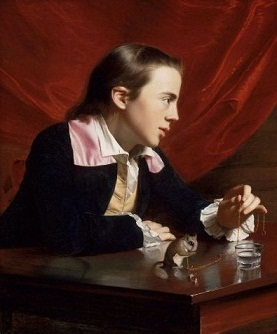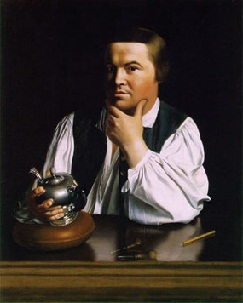Did Paul Revere copy the Boston Massacre image without permission?
One of the most recognizable works of the Boston’s most famous silversmith was the engraving called “The Bloody Massacre Perpetrated in King’s Street” otherwise known as the Boston Massacre engraving. The subject of the engraving is the famous Boston Massacre incident that led to the American Revolution. On March 5, 1770 a confrontation erupted between the British regulars standing on guard in front of the Customs House and a crowd of citizens. The scuffle began with the colonists shouting names, quickly escalated into throwing snowballs and rocks and ended with the soldiers firing on the crowd and killing five men.
 |
Henry Pelham's portrait by John Singleton Copley
|
P.R. himself was likely not present at the Boston Massacre that occurred five years prior to the Midnight Ride. And even though the first Correspondence Committee was created in 1764, it was not until much later when Revere’s patriot intelligence group called the Mechanics started patrolling Boston at nights monitoring every move of the British soldiers. P.R. made up for his absence with the subsequent effort that he put into making the case against the British oppression of the colonies by using the drama of the Boston Massacre. In the era before television and glossy photo publications, newspapers were the primary media for spreading the news. But it is often said that one picture is worth thousands of words, therefore colorful mass-produced prints were the next best thing to the actually being there. By today’s standards the engraving looks simple and even cartoonish but at that time it stirred up the hearts and minds of Bostonians against the “tyranny” of the British. Therefore the patriot was in a great rush to give the people of Boston a chance to see the massacre with their own eyes.
P.R. was a skillful silversmith and an engraver but he was not an artist. To make the engraving he needed a realistic drawing to create the stamp. Enter Henry Pelham, a talented young painter and also himself an engraver. Henry was a half-brother of another famous American painter John Singleton Copley. Copley even drew Henry in one of his paintings called The Boy with the Squirrel.
According to Pelham, P.R shamelessly copied Pelham’s Boston Massacre drawing which he was still working on and used the image in the engraving. In fact the young painter was so outraged that he published a letter accusing him of “the most dishonorable act” of plagiarism as he knew that his opponent “was not capable of doing it unless you copied it from mine”.
 |
Paul Revere's portrait by John Singleton Copley
|
There are no accounts of Paul Revere’s reaction to the accusation, but as we know his print has eventually became iconic.
The silversmith appeared to have altered few details of Pelham’s image which may suggest that he was trying to hide the plagiarism. But in those days copying somebody’s work may not had been something to frown upon. On the contrary it could be considered recognition of talent of the original creator. Therefore P.R. may have seen nothing wrong with using drawings of others to create engravings which he had done on many other occasions.
P.R. ran a very successful silver business for years and knew well how to beat his competition. His version of the Boston Massacre made it to market at the end of March, 1770, just three week after the shooting had occurred. For an engraving with such level of details this was rather quick. Yes we said “to market” because the print was actually advertized for sale in the Boston Gazette for the “Price of Eight Pence Lawful Money. On the other hand Henry Pelham was perhaps more a creator than a businessman. His print was artistically superior but unfortunately took too long to complete. But we can’t help but feel for the young artist who possibly lost his chance to make his mark in American History.
Interestingly Pelham was a pro-British loyalist and was even once seriously attacked by a mob in Springfield, MA for being one of “a damn’d pack of Torys”. It is therefore unclear why he decided to create the Boston Massacre drawing which was clearly not flattering to the British troops depicted firing into unarmed men.
Even though the relationships between the two rivals artists were smoothed over in the later years, Henry Pelham ultimately left Boston with the British troops and settled in Ireland.
Read more about Paul Revere's involvement in the Boston Massacre >>
|